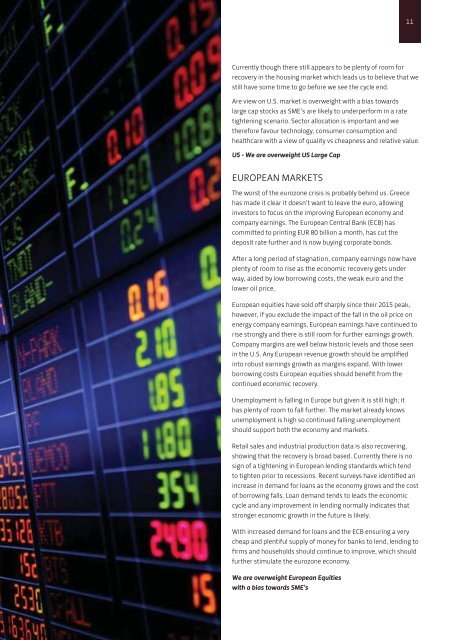Create successful ePaper yourself
Turn your PDF publications into a flip-book with our unique Google optimized e-Paper software.
11<br />
Currently though there still appears to be plenty of room for<br />
recovery in the housing market which leads us to believe that we<br />
still have some time to go before we see the cycle end.<br />
Are view on U.S. market is overweight with a bias towards<br />
large cap stocks as SME’s are likely to underperform in a rate<br />
tightening scenario. Sector allocation is important and we<br />
therefore favour technology, consumer consumption and<br />
healthcare with a view of quality vs cheapness and relative value.<br />
US - We are overweight US Large Cap<br />
EUROPEAN MARKETS<br />
The worst of the eurozone crisis is probably behind us. Greece<br />
has made it clear it doesn’t want to leave the euro, allowing<br />
investors to focus on the improving European economy and<br />
company earnings. The European Central Bank (ECB) has<br />
committed to printing EUR 80 billion a month, has cut the<br />
deposit rate further and is now buying corporate bonds.<br />
After a long period of stagnation, company earnings now have<br />
plenty of room to rise as the economic recovery gets under<br />
way, aided by low borrowing costs, the weak euro and the<br />
lower oil price.<br />
European equities have sold off sharply since their 2015 peak,<br />
however, if you exclude the impact of the fall in the oil price on<br />
energy company earnings, European earnings have continued to<br />
rise strongly and there is still room for further earnings growth.<br />
Company margins are well below historic levels and those seen<br />
in the U.S. Any European revenue growth should be amplified<br />
into robust earnings growth as margins expand. With lower<br />
borrowing costs European equities should benefit from the<br />
continued economic recovery.<br />
Unemployment is falling in Europe but given it is still high; it<br />
has plenty of room to fall further. The market already knows<br />
unemployment is high so continued falling unemployment<br />
should support both the economy and markets.<br />
Retail sales and industrial production data is also recovering,<br />
showing that the recovery is broad based. Currently there is no<br />
sign of a tightening in European lending standards which tend<br />
to tighten prior to recessions. Recent surveys have identified an<br />
increase in demand for loans as the economy grows and the cost<br />
of borrowing falls. Loan demand tends to leads the economic<br />
cycle and any improvement in lending normally indicates that<br />
stronger economic growth in the future is likely.<br />
With increased demand for loans and the ECB ensuring a very<br />
cheap and plentiful supply of money for banks to lend, lending to<br />
firms and households should continue to improve, which should<br />
further stimulate the eurozone economy.<br />
We are overweight European Equities<br />
with a bias towards SME’s


